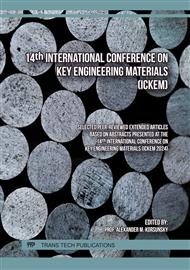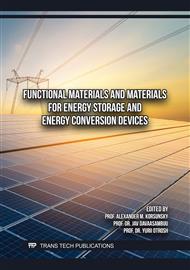[1]
S. U. Rahman et al., "Toxic effects of lead (Pb), cadmium (Cd) and tetracycline (TC) on the growth and development of Triticum aestivum: A meta-analysis," Science of the Total Environment, Review vol. 904, 2023, Art. no. 166677.
DOI: 10.1016/j.scitotenv.2023.166677
Google Scholar
[2]
A. A. Marticorena, B. A. Mandagarán, and E. A. J. I. t. Campanella, "Análisis del Impacto Ambiental de la Recuperación de Metanol en la Producción de Biodiesel usando el Algoritmo de Reducción de Desechos WAR," vol. 21, no. 1, pp.23-30, 2010.
DOI: 10.4067/s0718-07642010000100005
Google Scholar
[3]
P. A. Calvo and M. S. C. J. R. M. S. Díaz, "Intoxicación por metanol," vol. 6, no. 9, pp. e701-e701, 2021.
DOI: 10.31434/rms.v6i9.701
Google Scholar
[4]
O. S. Stamenković, A. V. Veličković, and V. B. J. F. Veljković, "The production of biodiesel from vegetable oils by ethanolysis: Current state and perspectives," vol. 90, no. 11, pp.3141-3155, 2011.
DOI: 10.1016/j.fuel.2011.06.049
Google Scholar
[5]
R. Guzatto, D. Defferrari, Q. B. Reiznautt, Í. R. Cadore, and D. J. F. Samios, "Transesterification double step process modification for ethyl ester biodiesel production from vegetable and waste oils," vol. 92, no. 1, pp.197-203, 2012.
DOI: 10.1016/j.fuel.2011.08.010
Google Scholar
[6]
R. J. C. Heiden, "Analytical Methodologies for the Determination of Biodiesel Ester Purity Determination of Total Methyl Esters: Final NBB Report Lancaster," p.520320-l.
Google Scholar
[7]
D. H. Gómez Miranda, "Aprovechamiento de la grasa bovina del Camal Frigorífico Municipal Ambato para la obtención de biodiésel como combustible de origen animal," Universidad Técnica de Ambato. Facultad de Ciencia e Ingeniería en Alimentos …, 2016.
DOI: 10.34098/2078-3949.41.1.3
Google Scholar
[8]
M. F. M. Yusoff, X. Xu, and Z. J. J. o. t. A. O. C. S. Guo, "Comparison of fatty acid methyl and ethyl esters as biodiesel base stock: a review on processing and production requirements," vol. 91, pp.525-531, 2014.
DOI: 10.1007/s11746-014-2443-0
Google Scholar
[9]
L. Panichelli, L. Trama, and A. J. U. d. B. A. B. A. Dauriat, "Análisis de Ciclo de Vida (ACV) de la producción de biodiesel (B100) en Argentina," 2006.
Google Scholar
[10]
J. S. Requena et al., "Life Cycle Assessment (LCA) of the biofuel production process from sunflower oil, rapeseed oil and soybean oil," vol. 92, no. 2, pp.190-199, 2011.
DOI: 10.1016/j.fuproc.2010.03.004
Google Scholar
[11]
F. H. Sobrino, C. R. Monroy, J. L. H. J. R. Pérez, and S. E. Reviews, "Biofuels and fossil fuels: Life Cycle Analysis (LCA) optimisation through productive resources maximisation," vol. 15, no. 6, pp.2621-2628, 2011.
DOI: 10.1016/j.rser.2011.03.010
Google Scholar
[12]
E. Audsley et al., "Harmonisation of environmental life cycle assessment for agriculture," vol. 139, no. 1, 1997.
Google Scholar
[13]
S. Sala et al., "Recommended life impact assessment methods for ILCD and Environmental Footprint: challenges, opportunities and updates," 2015.
Google Scholar
[14]
M. Amin, E. Chung, H. J. I. J. o. E. S. Shah, and Technology, "Effect of different activation agents for activated carbon preparation through characterization and life cycle assessment," vol. 20, no. 7, pp.7645-7656, 2023.
DOI: 10.1007/s13762-022-04472-6
Google Scholar
[15]
A. J. T. i. j. o. l. c. a. Ciroth, "ICT for environment in life cycle applications openLCA—A new open source software for life cycle assessment," vol. 12, pp.209-210, 2007.
DOI: 10.1007/s11367-007-0337-1
Google Scholar
[16]
P. Caramazana, P. Dunne, M. Gimeno-Fabra, J. McKechnie, E. J. C. O. i. G. Lester, and S. Chemistry, "A review of the environmental impact of nanomaterial synthesis using continuous flow hydrothermal synthesis," vol. 12, pp.57-62, 2018.
DOI: 10.1016/j.cogsc.2018.06.016
Google Scholar
[17]
D. NEN, "NEN-EN-ISO 14067: 2018 (en)-Greenhouse gases-Carbon footprint of products-Requirements and guidelines for quantification," 2018.
Google Scholar
[18]
R. E. Morales Blas, "Huella de Carbono en el Alcance 1 y 2, utilizando la metodología del GreenHouse Gas Protocol (GHG Protocol) y la Norma ISO 14064-1: 2006, en el Centro de Producción "Productos Unión"," 2018.
DOI: 10.33936/revbasdelaciencia.v7i3.4315
Google Scholar
[19]
S. P. Souza, M. T. de Ávila, S. J. b. Pacca, and bioenergy, "Life cycle assessment of sugarcane ethanol and palm oil biodiesel joint production," vol. 44, pp.70-79, 2012.
DOI: 10.1016/j.biombioe.2012.04.018
Google Scholar
[20]
S. Rinaldi, M. Barbanera, and E. J. S. o. T. T. E. Lascaro, "Assessment of carbon footprint and energy performance of the extra virgin olive oil chain in Umbria, Italy," vol. 482, pp.71-79, 2014.
DOI: 10.1016/j.scitotenv.2014.02.104
Google Scholar
[21]
G. Quiroga, C. Rojas Correal, and L. E. Peñaloza Soler, "Transporte, sacrificio y faenado de ganado," 1989.
Google Scholar
[22]
M. Bowman, D. Hilligoss, S. Rasmussen, and R. J. H. p. Thomas, "Biodiesel: a renewable and biodegradable fuel," vol. 85, no. 2, p.103, 2006.
Google Scholar
[23]
T. Bradley, D. J. M. L. P. M. Maga, and Protocols, "Life cycle analysis of producing microbial lipids and biodiesel: comparison with plant lipids," pp.195-214, 2019.
DOI: 10.1007/978-1-4939-9484-7_13
Google Scholar



